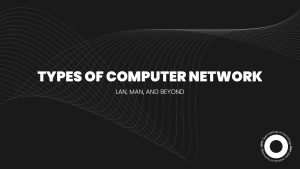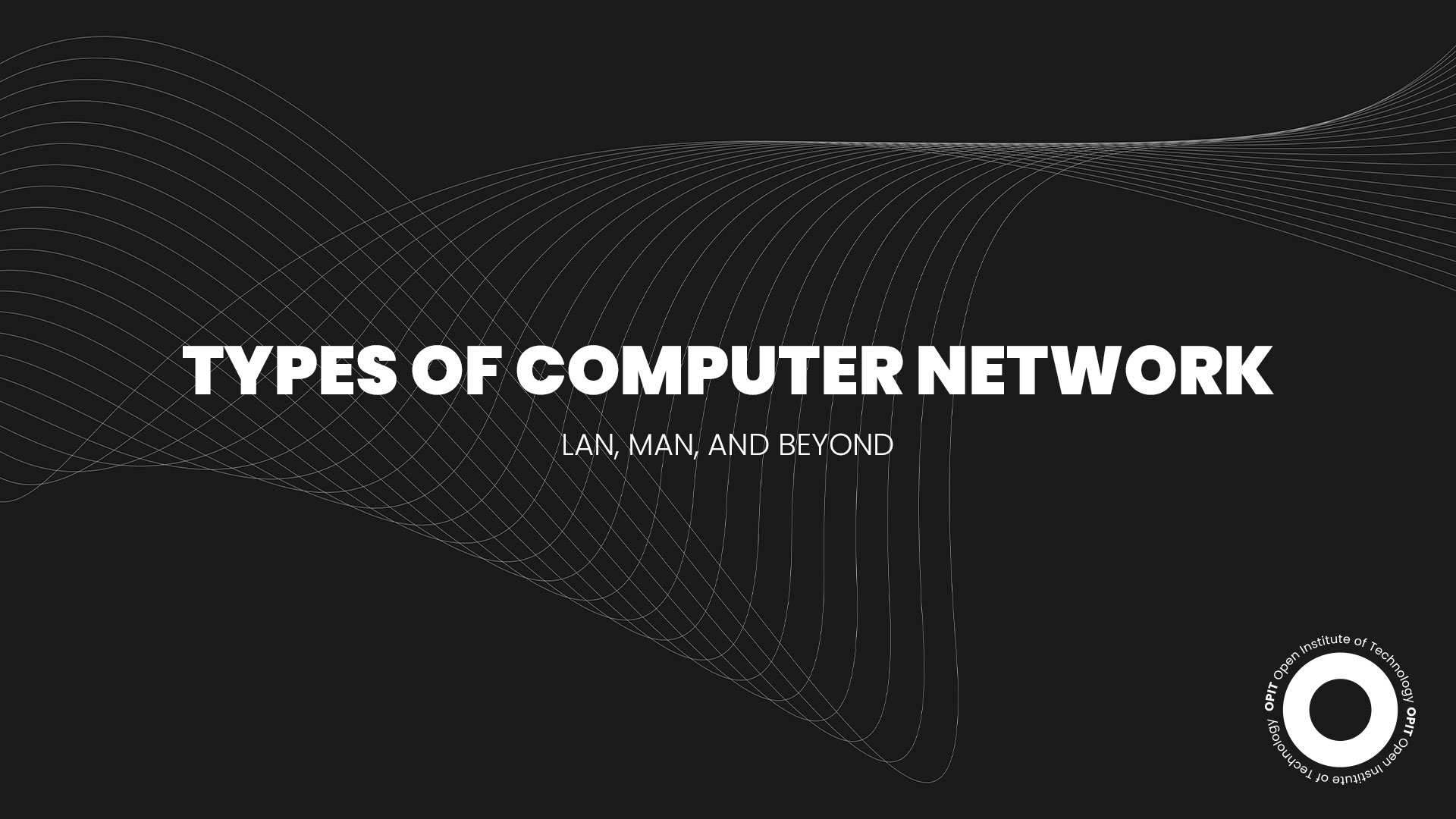

From the local network you’re probably using to read this article to the entirety of the internet, you’re surrounded by computer networks wherever you go.
A computer network connects at least two computer systems using a medium. Sharing the same connection protocols, the computers within such networks can communicate with each other and exchange data, resources, and applications.
In an increasingly technological world, several types of computer network have become the thread that binds modern society. They differ in size (geographic area or the number of computers), purpose, and connection modes (wired or wireless). But they all have one thing in common: they’ve fueled the communication revolution worldwide.
This article will explore the intricacies of these different network types, delving into their features, advantages, and disadvantages.
Local Area Network (LAN)
Local Area Network (LAN) is a widely used computer network type that covers the smallest geographical area (a few miles) among the three main types of computer network (LAN, MAN, and WAN).
A LAN usually relies on wired connections since they are faster than their wireless counterparts. With a LAN, you don’t have to worry about external regulatory oversight. A LAN is a privately owned network.
Looking into the infrastructure of a LAN, you’ll typically find several devices (switches, routers, adapters, etc.), many network cables (Ethernet, fiber optic, etc.), and specific internet protocols (Ethernet, TCP/IP, Wi-Fi, etc.).
As with all types of computer network, a LAN has its fair share of advantages and disadvantages.
Users who opt for a LAN usually do so due to the following reasons:
- Setting up and managing a LAN is easy.
- A LAN provides fast data and message transfer.
- Even inexpensive hardware (hard disks, DVD-ROMs, etc.) can share a LAN.
- A LAN is more secure and offers increased fault tolerance than a WAN.
- All LAN users can share a single internet connection.
As for the drawbacks, these are some of the more concerning ones:
- A LAN is highly limited in geographical coverage. (Any growth requires costly infrastructure upgrades.)
- As more users connect to the network, it might get congested.
- A LAN doesn’t offer a high degree of privacy. (The admin can see the data files of each user.)
Regardless of these disadvantages, many people worldwide use a LAN. In computer networks, no other type is as prevalent. Look at virtually any home, office building, school, laboratory, hospital, and similar facilities, and you’ll probably spot a LAN.
Wide Area Network (WAN)
Do you want to experience a Wide Area Network (WAN) firsthand? Since you’re reading this article, you’ve already done so. That’s right. The internet is one of the biggest WANs in the world.
So, it goes without saying that a WAN is a computer network that spans a large geographical area. Of course, the internet is an outstanding example; most WANs are confined within the borders of a country or even limited to an enterprise.
Considering that a WAN needs to cover a considerable distance, it isn’t surprising it relies on connections like satellite links to transmit the data. Other components of a WAN include standard network devices (routers, modems, etc.) and network protocols (TCP/IP, MPLS, etc.).
The ability of a WAN to cover a large geographical area is one of its most significant advantages. But it’s certainly not the only one.
- A WAN offers remote access to shared software and other resources.
- Numerous users and applications can use a WAN simultaneously.
- A WAN facilitates easy communication between computers within the same network.
- With WAN, all data is centralized (no need to purchase separate backup servers, emails, etc.).
Of course, as with other types of computer network, there are some disadvantages to note.
- Setting up and maintaining a WAN is costly and challenging.
- Due to the higher distance, there can be some issues with the slower data transfer and delays.
- The use of multiple technologies can create security issues for the network. (A firewall, antivirus software, and other preventative security measures are a must.)
By now, you probably won’t be surprised that the most common uses of a WAN are dictated by its impressive size.
You’ll typically find WANs connecting multiple LANs, branches of the same institution (government, business, finance, education, etc.), and the residents of a city or a country (public networks, mobile broadband, fiber internet services, etc.).
Metropolitan Area Network (MAN)
A Metropolitan Area Network (MAN) interconnects different LANs to cover a larger geographical area (usually a town or a city). To put this into perspective, a MAN covers more than a LAN but less than a WAN.
A MAN offers high-speed connectivity and mainly relies on optical fibers. “Moderate” is the word that best describes a MAN’s data transfer rate and propagation delay.
You’ll need standard network devices like routers and switches to establish this network. As for transmission media, a MAN primarily relies on fiber optic cables and microwave links. The last component to consider is network protocols, which are also pretty standard (TCP/IP, Ethernet, etc.)
There are several reasons why internet users opt for a MAN in computer networks:
- A MAN can be used as an Internet Service Provider (ISP).
- Through a MAN, you can gain greater access to WANs.
- A dual connectivity bus allows simultaneous data transfer both ways.
Unfortunately, this network type isn’t without its flaws.
- A MAN can be expensive to set up and maintain. (For instance, it requires numerous cables.)
- The more users use a MAN, the more congestion and performance issues can ensue.
- Ensuring cybersecurity on this network is no easy task.
Despite these disadvantages, many government agencies fully trust MANs to connect to the citizens and private industries. The same goes for public services like high-speed DSL lines and cable TV networks within a city.
Personal Area Network (PAN)
The name of this network type will probably hint at how this network operates right away. In other words, a Personal Area Network (PAN) is a computer network centered around a single person. As such, it typically connects a person’s personal devices (computer, mobile phone, tablet, etc.) to the internet or a digital network.
With such focused use, geographical limits shouldn’t be surprising. A PAN covers only about 33 feet of area. To expand the reach of this low-range network, users employ wireless technologies (Wi-Fi, Bluetooth, etc.)
With these network connections and the personal devices that use the network out of the way, the only remaining components of a PAN are the network protocols it uses (TCP/IP, Bluetooth, etc.).
Users create these handy networks primarily due to their convenience. Easy setup, straightforward communications, no wires or cables … what’s not to like? Throw energy efficiency into the mix, and you’ll understand the appeal of PANs.
Of course, something as quick and easy as a PAN doesn’t go hand in hand with large-scale data transfers. Considering the limited coverage area and bandwidth, you can bid farewell to high-speed communication and handling large amounts of data.
Then again, look at the most common uses of PANs, and you’ll see that these are hardly needed. PANs come in handy for connecting personal devices, establishing an offline network at home, and connecting devices (cameras, locks, speakers, etc.) within a smart home setup.
Wireless Local Area Network (WLAN)
You’ll notice only one letter difference between WLAN and LAN. This means that this network operates similarly to a LAN, but the “W” indicates that it does so wirelessly. It extends the LAN’s reach, making a Wireless Local Area Network (WLAN) ideal for users who hate dealing with cables yet want a speedy and reliable network.
A WLAN owes its seamless operation to network connections like radio frequency and Wi-Fi. Other components that you should know about include network devices (wireless routers, access points, etc.) and network protocols (TCP/IP, Wi-Fi, etc.).
Flexible. Reliable. Robust. Mobile. Simple. Those are just some adjectives that accurately describe WLANs and make them such an appealing network type.
Of course, there are also a few disadvantages to note, especially when comparing WLANs to LANs.
WLANs offer less capacity, security, and quality than their wired counterparts. They’re also more expensive to install and vulnerable to various interferences (physical objects obstructing the signal, other WLAN networks, electronic devices, etc.).
Like LANs, you will likely see WLANs in households, office buildings, schools, and similar locations.
Virtual Private Network (VPN)
If you’re an avid internet user, you’ve probably encountered this scenario: you want to use public Wi-Fi but fear the consequences and stream specific content. Or this one may be familiar: you want to use apps, but they’re unavailable in your country. The solution for both cases is a VPN.
A Virtual Private Network, or VPN for short, uses tunneling protocols to create a private network over a less secure public network. You’ll probably have to pay to access a premium virtual connection, but this investment is well worth it.
A VPN provider typically offers servers worldwide, each a valuable component of a VPN. Besides the encrypted tunneling protocols, some VPNs use the internet itself to establish a private connection. As for network protocols, you’ll mostly see TCP/IP, SSL, and similar types.
The importance of security and privacy on the internet can’t be understated. So, a VPN’s ability to offer you these is undoubtedly its biggest advantage. Users are also fond of VPNs for unlocking geo-blocked content and eliminating pesky targeted ads.
Following in the footsteps of other types of computer network, a VPN also has a few notable flaws. Not all devices will support this network. Even when they do, privacy and security aren’t 100% guaranteed. Just think of how fast new cybersecurity threats emerge, and you’ll understand why.
Of course, these downsides don’t prevent numerous users from reaching for VPNs to secure remote access to the internet or gain access to apps hosted on proprietary networks. Users also use these networks to bypass censorship in their country or browse the internet anonymously.
Connecting Beyond Boundaries
Whether running a global corporation or wanting to connect your smartphone to the internet, there’s a perfect network among the above-mentioned types of computer network. Understanding the unique features of each network and their specific advantages and disadvantages will help you make the right choice and enjoy seamless connections wherever you are. Compare the facts from this guide to your specific needs, and you’ll pick the perfect network every time.
Related posts

Source:
- Agenda Digitale, published on November 25th, 2025
In recent years, the word ” sustainability ” has become a firm fixture in the corporate lexicon. However, simply “doing no harm” is no longer enough: the climate crisis , social inequalities , and the erosion of natural resources require a change of pace. This is where the net-positive paradigm comes in , a model that isn’t content to simply reduce negative impacts, but aims to generate more social and environmental value than is consumed.
This isn’t about philanthropy, nor is it about reputational makeovers: net-positive is a strategic approach that intertwines economics, technology, and corporate culture. Within this framework, digitalization becomes an essential lever, capable of enabling regenerative models through circular platforms and exponential technologies.
Blockchain, AI, and IoT: The Technological Triad of Regeneration
Blockchain, Artificial Intelligence, and the Internet of Things represent the technological triad that makes this paradigm shift possible. Each addresses a critical point in regeneration.
Blockchain guarantees the traceability of material flows and product life cycles, allowing a regenerated dress or a bottle collected at sea to tell their story in a transparent and verifiable way.
Artificial Intelligence optimizes recovery and redistribution chains, predicting supply and demand, reducing waste and improving the efficiency of circular processes .
Finally, IoT enables real-time monitoring, from sensors installed at recycling plants to sharing mobility platforms, returning granular data for quick, informed decisions.
These integrated technologies allow us to move beyond linear vision and enable systems in which value is continuously regenerated.
New business models: from product-as-a-service to incentive tokens
Digital regeneration is n’t limited to the technological dimension; it’s redefining business models. More and more companies are adopting product-as-a-service approaches , transforming goods into services: from technical clothing rentals to pay-per-use for industrial machinery. This approach reduces resource consumption and encourages modular design, designed for reuse.
At the same time, circular marketplaces create ecosystems where materials, components, and products find new life. No longer waste, but input for other production processes. The logic of scarcity is overturned in an economy of regenerated abundance.
To complete the picture, incentive tokens — digital tools that reward virtuous behavior, from collecting plastic from the sea to reusing used clothing — activate global communities and catalyze private capital for regeneration.
Measuring Impact: Integrated Metrics for Net-Positiveness
One of the main obstacles to the widespread adoption of net-positive models is the difficulty of measuring their impact. Traditional profit-focused accounting systems are not enough. They need to be combined with integrated metrics that combine ESG and ROI, such as impact-weighted accounting or innovative indicators like lifetime carbon savings.
In this way, companies can validate the scalability of their models and attract investors who are increasingly attentive to financial returns that go hand in hand with social and environmental returns.
Case studies: RePlanet Energy, RIFO, and Ogyre
Concrete examples demonstrate how the combination of circular platforms and exponential technologies can generate real value. RePlanet Energy has defined its Massive Transformative Purpose as “Enabling Regeneration” and is now providing sustainable energy to Nigerian schools and hospitals, thanks in part to transparent blockchain-based supply chains and the active contribution of employees. RIFO, a Tuscan circular fashion brand, regenerates textile waste into new clothing, supporting local artisans and promoting workplace inclusion, with transparency in the production process as a distinctive feature and driver of loyalty. Ogyre incentivizes fishermen to collect plastic during their fishing trips; the recovered material is digitally tracked and transformed into new products, while the global community participates through tokens and environmental compensation programs.
These cases demonstrate how regeneration and profitability are not contradictory, but can actually feed off each other, strengthening the competitiveness of businesses.
From Net Zero to Net Positive: The Role of Massive Transformative Purpose
The crucial point lies in the distinction between sustainability and regeneration. The former aims for net zero, that is, reducing the impact until it is completely neutralized. The latter goes further, aiming for a net positive, capable of giving back more than it consumes.
This shift in perspective requires a strong Massive Transformative Purpose: an inspiring and shared goal that guides strategic choices, preventing technology from becoming a sterile end. Without this level of intentionality, even the most advanced tools risk turning into gadgets with no impact.
Regenerating business also means regenerating skills to train a new generation of professionals capable not only of using technologies but also of directing them towards regenerative business models. From this perspective, training becomes the first step in a transformation that is simultaneously cultural, economic, and social.
The Regenerative Future: Technology, Skills, and Shared Value
Digital regeneration is not an abstract concept, but a concrete practice already being tested by companies in Europe and around the world. It’s an opportunity for businesses to redefine their role, moving from mere economic operators to drivers of net-positive value for society and the environment.
The combination of blockchain, AI, and IoT with circular product-as-a-service models, marketplaces, and incentive tokens can enable scalable and sustainable regenerative ecosystems. The future of business isn’t just measured in terms of margins, but in the ability to leave the world better than we found it.

Source:
- Raconteur, published on November 06th, 2025
Many firms have conducted successful Artificial Intelligence (AI) pilot projects, but scaling them across departments and workflows remains a challenge. Inference costs, data silos, talent gaps and poor alignment with business strategy are just some of the issues that leave organisations trapped in pilot purgatory. This inability to scale successful experiments means AI’s potential for improving enterprise efficiency, decision-making and innovation isn’t fully realised. So what’s the solution?
Although it’s not a magic bullet, an AI operating model is really the foundation for scaling pilot projects up to enterprise-wide deployments. Essentially it’s a structured framework that defines how the organisation develops, deploys and governs AI. By bringing together infrastructure, data, people, and governance in a flexible and secure way, it ensures that AI delivers value at scale while remaining ethical and compliant.
“A successful AI proof-of-concept is like building a single race car that can go fast,” says Professor Yu Xiong, chair of business analytics at the UK-based Surrey Business School. “An efficient AI technology operations model, however, is the entire system – the processes, tools, and team structures – for continuously manufacturing, maintaining, and safely operating an entire fleet of cars.”
But while the importance of this framework is clear, how should enterprises establish and embed it?
“It begins with a clear strategy that defines objectives, desired outcomes, and measurable success criteria, such as model performance, bias detection, and regulatory compliance metrics,” says Professor Azadeh Haratiannezhadi, co-founder of generative AI company Taktify and professor of generative AI in cybersecurity at OPIT – the Open Institute of Technology.
Platforms, tools and MLOps pipelines that enable models to be deployed, monitored and scaled in a safe and efficient way are also essential in practical terms.
“Tools and infrastructure must also be selected with transparency, cost, and governance in mind,” says Efrain Ruh, continental chief technology officer for Europe at Digitate. “Crucially, organisations need to continuously monitor the evolving AI landscape and adapt their models to new capabilities and market offerings.”
An open approach
The most effective AI operating models are also founded on openness, interoperability and modularity. Open source platforms and tools provide greater control over data, deployment environments and costs, for example. These characteristics can help enterprises to avoid vendor lock-in, successfully align AI to business culture and values, and embed it safely into cross-department workflows.
“Modularity and platformisation…avoids building isolated ‘silos’ for each project,” explains professor Xiong. “Instead, it provides a shared, reusable ‘AI platform’ that integrates toolchains for data preparation, model training, deployment, monitoring, and retraining. This drastically improves efficiency and reduces the cost of redundant work.”
A strong data strategy is equally vital for ensuring high-quality performance and reducing bias. Ideally, the AI operating model should be cloud and LLM agnostic too.
“This allows organisations to coordinate and orchestrate AI agents from various sources, whether that’s internal or 3rd party,” says Babak Hodjat, global chief technology officer of AI at Cognizant. “The interoperability also means businesses can adopt an agile iterative process for AI projects that is guided by measuring efficiency, productivity, and quality gains, while guaranteeing trust and safety are built into all elements of design and implementation.”
A robust AI operating model should feature clear objectives for compliance, security and data privacy, as well as accountability structures. Richard Corbridge, chief information officer of Segro, advises organisations to: “Start small with well-scoped pilots that solve real pain points, then bake in repeatable patterns, data contracts, test harnesses, explainability checks and rollback plans, so learning can be scaled without multiplying risk. If you don’t codify how models are approved, deployed, monitored and retired, you won’t get past pilot purgatory.”
Of course, technology alone can’t drive successful AI adoption at scale: the right skills and culture are also essential for embedding AI across the enterprise.
“Multidisciplinary teams that combine technical expertise in AI, security, and governance with deep business knowledge create a foundation for sustainable adoption,” says Professor Haratiannezhadi. “Ongoing training ensures staff acquire advanced AI skills while understanding associated risks and responsibilities.”
Ultimately, an AI operating model is the playbook that enables an enterprise to use AI responsibly and effectively at scale. By drawing together governance, technological infrastructure, cultural change and open collaboration, it supports the shift from isolated experiments to the kind of sustainable AI capability that can drive competitive advantage.
In other words, it’s the foundation for turning ambition into reality, and finally escaping pilot purgatory for good.
Have questions?
Visit our FAQ page or get in touch with us!
Write us at +39 335 576 0263
Get in touch at hello@opit.com
Talk to one of our Study Advisors
We are international
We can speak in:


